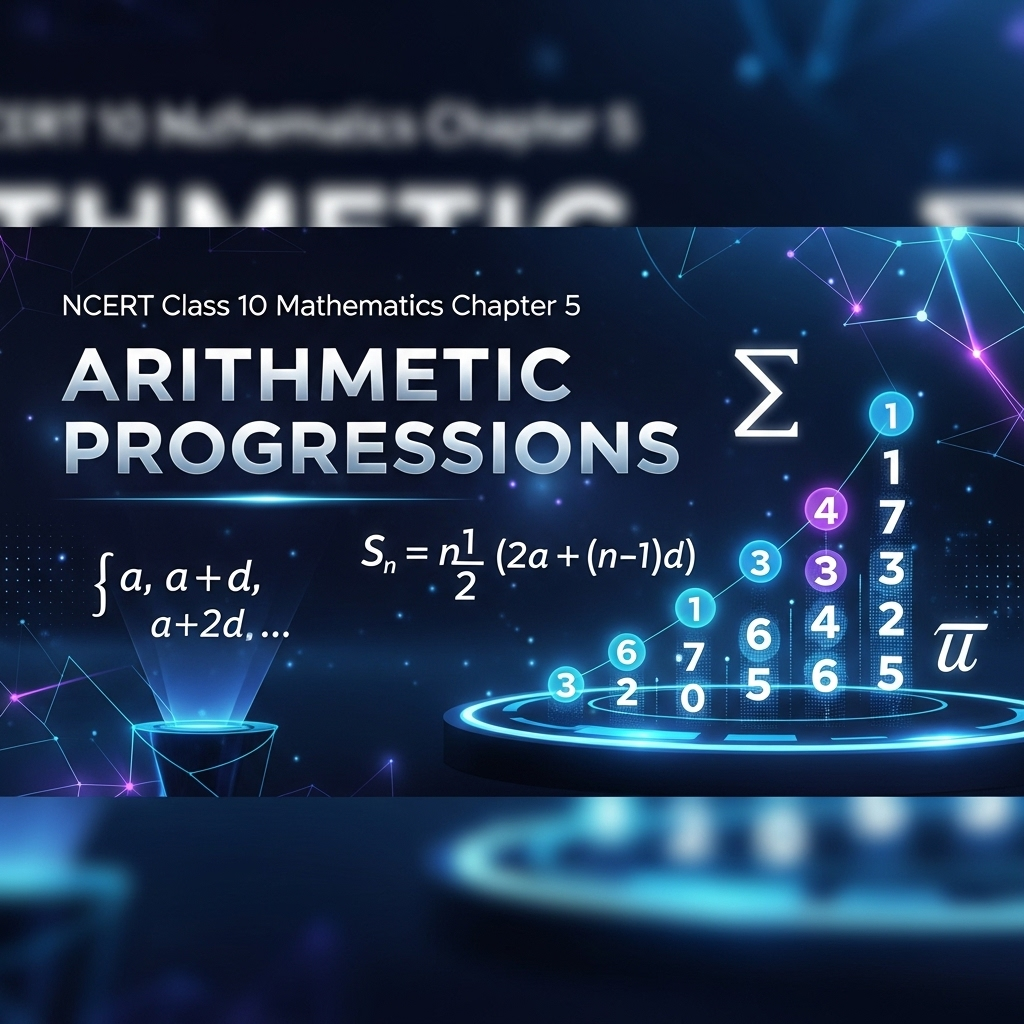Complete Solutions and Summary of Arithmetic Progressions – NCERT Class 10, Mathematics, Chapter 5 – Summary, Questions, Answers, Extra Questions
Comprehensive summary and explanation of Chapter 5 'Arithmetic Progressions', covering the definition and identification of APs, derivation of the general term, finding the nth term, calculation of the sum of n terms, practical examples, and a variety of solved and extra practice problems drawn from daily life and real-world scenarios, all aligned with NCERT Class X Mathematics.
Updated: 1 month ago
Categories: NCERT, Class X, Mathematics, Summary, Extra Questions, Arithmetic Progressions, Algebra, Sequences, Chapter 5

Arithmetic Progressions
Chapter 5: Mathematics - Ultimate Study Guide | NCERT Class 10 Notes, Questions, Examples & Quiz 2025
Full Chapter Summary & Detailed Notes - Arithmetic Progressions Class 10 NCERT
Overview & Key Concepts
- Chapter Goal: Understand arithmetic progressions, nth term, sum of terms, applications. Exam Focus: Identifying AP, formulas, word problems. 2025 Updates: Real-life patterns. Fun Fact: Gauss summed 1 to 100 quickly. Core Idea: Sequences with constant difference. Real-World: Salary increments, ladder rungs, savings.
- Wider Scope: Foundation for sequences, series in higher maths.
5.1 Introduction
- Patterns in nature: sunflower petals, honeycomb, maize grains, pineapple spirals.
- Daily life examples: Salary 8000 +500 annual, rungs 45,43,...,31 cm, savings 5/4 times every 3 years, unit squares 1²,2²,..., money box 100+50 yearly, rabbits 1,1,2,3,5,8 (Fibonacci, not AP).
- Patterns: Adding fixed, multiplying, squares, etc. Focus on adding fixed (AP).
5.2 Arithmetic Progressions
- List where each term = previous + fixed d (common difference).
- Examples: 1,2,3,... (d=1); 100,70,40,10 (d=-30); -3,-2,-1,0 (d=1); 3,3,3 (d=0); -1.0,-1.5,-2.0 (d=-0.5).
- General: a, a+d, a+2d,...
- Finite (last term), infinite (no last).
- Check AP: Differences same.
Example 1: First Term and d
- For 3/2, 1/2, -1/2, -3/2,... a=3/2, d=-1.
Example 2: Check AP and Next Terms
- (i) 4,10,16,22,... d=6, yes; next 28,34.
- (ii) 1,-1,-3,-5,... d=-2, yes; next -7,-9.
- (iii) -2,2,-2,2,... differences 4,-4, not same, no.
- (iv) 1,1,1,2,2,2,3,... differences 0,0,1, not same, no.
Exercise 5.1
- Situations form AP? Taxi fare, air removal, well digging, compound interest.
- First four terms given a,d.
- First term, d from APs.
- Which are APs? Write next three.
5.3 nth Term of an AP
- an = a + (n-1)d
- Last term l = a + (m-1)d for m terms.
Example 3: 10th Term
- 2,7,12,... a=2,d=5; a10=2+9*5=47.
Example 4: Which Term -81
- 21,18,15,... a=21,d=-3; 21+(n-1)(-3)=-81 → n=35. For 0: n=8.
Example 5: Determine AP
- a3=5, a7=9; solve a+2d=5, a+6d=9 → d=1, a=3. AP:3,4,5,6,...
Example 6: Check 301 in 5,11,17,23,...
- a=5,d=6; 5+(n-1)6=301 → n=302/6=50.333, not integer, no.
Example 7: Two-Digit Divisible by 3
- 12,15,...,99; a=12,d=3; 12+(n-1)3=99 → n=30.
Example 8: 11th from Last
- 10,7,4,...,-62; a=10,d=-3; n=25 terms. 11th from last =15th from first:10+14*(-3)=-32. Reverse: a=-62,d=3; a11=-62+10*3=-32.
Example 9: Interest 1000 at 8%
- Interests 80,160,240,... d=80,a=80. a30=80+29*80=2400.
Example 10: Rose Plants
- 23,21,19,...,5; a=23,d=-2; 23+(n-1)(-2)=5 → n=10.
Exercise 5.2
- Fill table a,d,n,an.
- Choose correct 30th/11th term.
- Missing terms in boxes.
- Which term 78.
- Number of terms in APs.
- Check term.
- 31st term given a11,a16.
- 50 terms, a3=12, last=106, find a29.
- Term zero.
- Common d exceeds by 7.
- Term 132 more.
- Same d, difference 100th=100, 1000th?
- Three-digit by 7.
- Multiples 4 between 10-250.
- Value n equal terms two APs.
- Determine AP a3=16, a7-a5=12.
- 20th from last 3,8,...,253.
- Sum a4+a8=24, a6+a10=44, first three.
- Salary 5000 +200 yearly, year 7000.
- Savings 5 +1.75 weekly, nth=20.75.
5.4 Sum of First n Terms of an AP
- Sn = n/2 [2a + (n-1)d] or n/2 (a + l)
- Gauss sum 1 to 100=5050.
- an = Sn - Sn-1
Example 11: Sum 22 Terms
- 8,3,-2,... a=8,d=-5; S22=22/2 [2*8 +21*(-5)]=11*(16-105)=-979.
Example 12: Sum 14 Terms=1050, a=10, Find a20
- S14=14/2 [2*10 +13 d]=1050 → 140+91d=1050 → d=10. a20=10+19*10=200.
Example 13: Terms Sum 78
- 24,21,18,... Sn=78. a=24,d=-3; n/2 [48 + (n-1)(-3)]=78 → n(51-3n)=156 → 3n²-51n+156=0 → n²-17n+52=0 → (n-4)(n-13)=0. n=4 or 13.
Example 14: Sum Positive Integers
- (i) 1 to 1000: 1000/2 (1+1000)=500500.
- (ii) 1 to n: n/2 (n+1).
Example 15: Sum 24 Terms an=3+2n
- a1=5,a2=7,... d=2. S24=24/2 [2*5 +23*2]=12*(10+46)=672.
Example 16: TV Production
- a3=600, a7=700; a+2d=600, a+6d=700 → d=25, a=550. a10=550+9*25=775. S7=7/2 [2*550 +6*25]=7/2*1250=4375.
Exercise 5.3
- Sum APs: 2,7,...10 terms; -37,-33,...12; 0.6,1.7,...100; 1/15,1/12,...11.
- Sums: 7+10.5+...+84; 34+32+...+10; -5-8-...-230.
- AP given values find others.
- Terms sum 636.
- a=5,l=45,S=400 find n,d.
- a=17,l=350,d=9 find n,S.
- Sum 22 terms d=7 a22=149.
- Sum 51 terms a2=14 a3=18.
- S7=49 S17=289 find Sn.
- Show an=3+4n or 9-5n, S15.
- Sn=4n-n² find a1,S2,a2,a3,a10,an.
- Sum 40 multiples 6.
- Sum 15 multiples 8.
- Sum odds 0-50.
- Penalty 200+50 daily, 30 days.
- Prizes 700 total, 20 less each.
- Trees sections classes 1-12, 3 sections.
- Semicircles length 13.
- Logs 200 stacked 20 bottom decreasing.
- Potato race distance 10 potatoes.
5.5 Summary
- AP: Each term +d to previous.
- ak+1 - ak =d same.
- an =a+(n-1)d.
- Sn =n/2 [2a+(n-1)d] or n/2 (a+l).
Why This Guide Stands Out
Complete chapter coverage: Notes, examples, Q&A (all NCERT + extras), quiz. Student-centric, exam-ready for 2025. Free & ad-free.
Key Themes & Tips
- Sequences: Constant difference.
- Formulas: nth, sum.
- Applications: Real patterns.
- Tip: Check d same; use formulas directly.
Exam Case Studies
Word problems on sums, terms, applications like logs, prizes.
Project & Group Ideas
- Model patterns; derive sum formula.
Group Discussions
No forum posts available.


